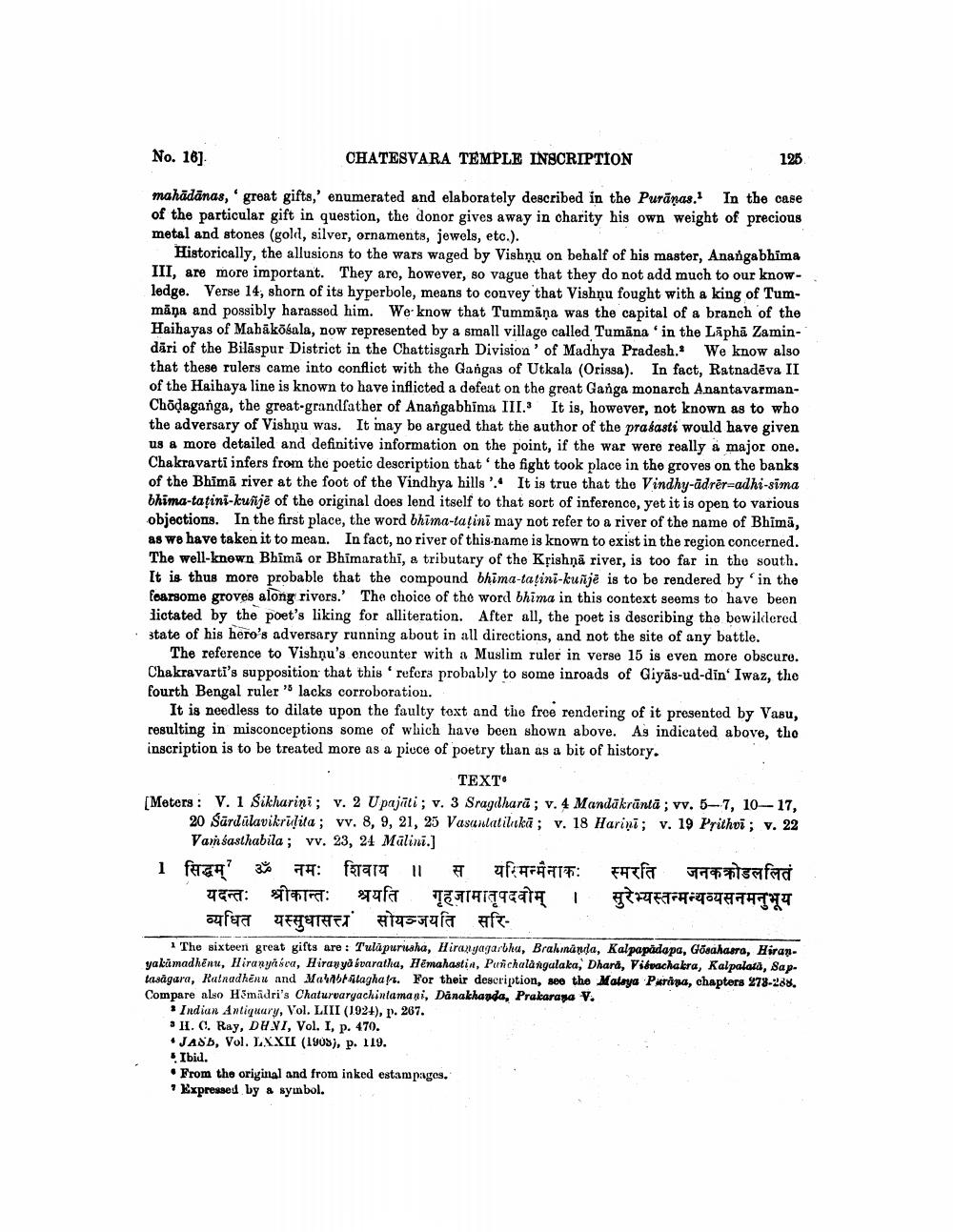________________
No. 16]
CHATESVARA TEMPLE INSCRIPTION
125
mahādānas,' great gifts,' enumerated and elaborately described in the Purānas. In the case of the particular gift in question, the donor gives away in charity his own weight of precious metal and stones (gold, silver, ornaments, jewels, etc.).
Historically, the allusions to the wars waged by Vishnu on behalf of his master, Anangabhima III, are more important. They are, however, so vague that they do not add much to our knowledge. Verse 14, shorn of its hyperbole, means to convey that Vishņu fought with a king of Tummăņa and possibly harassed him. We know that Tummana was the capital of a branch of the Haihayas of Mabākösala, now represented by a small village called Tumana 'in the Lāpha Zamindari of the Bilaspur District in the Chattisgarh Division of Madhya Pradesh. We know also that these rulers came into conflict with the Gangas of Utkala (Orissa). In fact, Ratnadēva II of the Haihaya line is known to have inflicted a defeat on the great Ganga monarch AnantavarmanChödaganga, the great-grandfather of Anangabhima III. It is, however, not known as to who the adversary of Vishnu was. It may be argued that the author of the prasasti would have given us a more detailed and definitive information on the point, if the war were really a major one. Chakravarti infers from the poetic description that the fight took place in the groves on the banks of the Bhimā river at the foot of the Vindhya hills. It is true that tho Vindhy-ādrēr-adhi-sima bhima-tatini-kusje of the original does lend itself to that sort of inferenco, yet it is open to various objections. In the first place, the word bhima-tațini may not refer to a river of the name of Bhimā, as we have taken it to mean. In fact, no river of this name is known to exist in the region concerned. The well-known Bhimă or Bhimarathi, a tributary of the Krishņā river, is too far in the south. It is thus more probable that the compound bhima-tațini-kusje is to be rendered by 'in the fearsome groves along rivors.' The choice of the word bhima in this context seems to have been
lictated by the poet's liking for alliteration. After all, the poet is describing the bewildered · state of his hero's adversary running about in all directions, and not the site of any battle.
The reference to Vishnu's encounter with a Muslim ruler in verse 15 is even more obscure. Chakravarti's supposition that this refera probably to some inroads of Giyās-ud-din Iwaz, the fourth Bengal ruler' lacks corroboration.
It is needless to dilate upon the faulty text and the froe rendering of it presented by Vasu, resulting in misconceptions some of which have been shown above. As indicated above, tho inscription is to be treated more as a piece of poetry than as a bit of history.
TEXT [Meters: V. 1 Sikharini; v. 2 U pajiti; v. 3 Sragdharā; v. 4 Mandākrānta ; vv. 5–7, 10-17,
20 Sārdülavikridita; vv. 8, 9, 21, 25 Vasanlatiluka; v. 18 Harini; v. 19 Prithvi ; v. 22
Vamsasthabila; vv. 23, 24 Mūlini.] 1 सिद्धम्' ॐ नमः शिवाय ॥ स यस्मिन्मनाक: स्मरति जनककोडललितं
यदन्तः श्रीकान्तः श्रयति गृहजामातृपदवीम् । सुरेभ्यस्तन्मन्यव्यसनमनुभूय
व्यधित यस्सुधासच सोयञ्जयति सरि
The sixteen great gifts are: Tulūpurusha, Hiranyagarbha, Brahmändla, Kalpapädapa, Gõsahasra, Hiranyakamadhēnu, Hiranya sed, Hirayyå svaratha, Hēmahastin, Punchalangalaka, Dhara, Vidvachakra, Kalpalata, Saptasågara, Ratnadhēnu and Mambalagha. For their description, see the Malaya Purina, chapters 273-288. Compare also H&madri's Chaturvaryachintamani, Danakhanda, Prakaraya V.
* Indian Antiquary, Vol. LIII (1924), p. 267.
11. C. Ray, DUNI, Vol. I, p. 470. • JASB, Vol. L.XXII (1908), p. 119. Ibid.
From the original and from inked estampages. * Expressed by a symbol.




